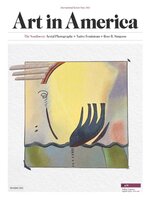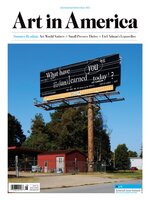Art in America, the world’s premier art magazine, delivers in-depth coverage of the global contemporary art scene. Published 11 times per year, every issue contains profiles on respected and rising talents, critical essays and reviews of current exhibitions around the world, written by today’s leading artists, curators and historians.
Art in America
Pay Attention
CONTRIBUTORS
Departments
Srijon Chowdhury • A new exhibition gets viewers inside the head of a rising Neo-Symbolist painter.
Science Fictions • A conversation on imagining the future by extrapolating from the past.
Mic Drop • A hard-up artist desperately seeks a show, and another needs some tips to raise the roof at karaoke.
Sacred Space • The Shaker Museum sets its sights on a new incarnation in Upstate New York.
Hello Cruel World • Working in Marfa, Texas, painter Julie Speed surveys humanity’s plight.
Apples to Apples • In an eclectic new book, T.J. Clark wrestles with the work of Paul Cézanne.
Books in Brief
OUR WORK IS WORKING • How art became a primary tool of the movement for disability justice.
Disability Culture So Far • Disabled artists and experts recall the moments that make up a movement.
IM.PAIR. MENT as IMPETUS • These five artworks by disabled artists show how impairment has served as a creative force throughout art history. Before today’s disability arts movement, the lived experience of disability prompted countless artists to explore interdependence, reimagine existing tools to suit their needs, and emphasize the importance of mechanisms for well-being.
REBECCA HORN • Finger Gloves (1972)
IBRAHIM NUBANI • Untitled (2006)
DARREL ELLIS • Untitled (ca. 1992)
ALICE RAHON • La balada para Frida Kahlo (The Ballad for Frida Kahlo), 1955–56
DAVID HOCKNEY • Tennis (1989)
WAYS OF NOT-SEEING • Blind and low-vision artists discuss their extravisual art.
EMILIE L. GOSSIAUX • The New York–based artist discusses her tactile drawing process and her relationship with her guide dog.
THE “MALADY” OF IMPRESSIONISM • A full account of the Impressionist movement must reckon with the role of disability and impairment in shaping both the art and its reception.
WHY BE NORMAL? • The lived experience of disability always involves practicing design. This long-overlooked expertise is now shaking up the field.
“52 Artists: A Feminist Milestone” • Aldrich Contemporary Art Museum, Ridgefield, Connecticut
FRONT International 2022 • Multiple venues, Cleveland
Clara Ianni • Amant, New York
William E. Jones • David Kordansky, New York
James Welling • Regen Projects, Los Angeles
Chadwick Rantanen • Bel Ami, Los Angeles
Rosa Bonheur • Musée des Beaux-Arts de Bordeaux, France
Amie Siegel • Thomas Dane Gallery, London
Ahmet Doğu İpek • Arter, Istanbul
Q & A • with Francisco echo Eraso, arts and access consultant

 Artnews Top 200 Collectors 2024
Artnews Top 200 Collectors 2024
 Fall 2024 - New Talent
Fall 2024 - New Talent
 Summer 2024
Summer 2024
 Spring 2024
Spring 2024
 Winter 2023
Winter 2023
 Fall 2023
Fall 2023
 May/June 2023
May/June 2023
 Mar 01 2023
Mar 01 2023
 The A.i.A. Guide 2023
The A.i.A. Guide 2023
 Dec 01 2022
Dec 01 2022
 Nov 01 2022
Nov 01 2022
 ARTnews Top 200 Collectors
ARTnews Top 200 Collectors
 Oct 01 2022
Oct 01 2022
 Sep 01 2022
Sep 01 2022
 June/July 2022
June/July 2022
 May 01 2022
May 01 2022
 Apr 01 2022
Apr 01 2022
 Mar 01 2022
Mar 01 2022
 Art in America Guide 2022
Art in America Guide 2022
 November/December 2021
November/December 2021
 September/October 2021
September/October 2021
 July/August 2021
July/August 2021
 May/June 2021
May/June 2021
